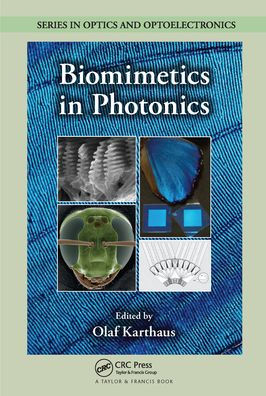Exploring a biomimetic approach to developing photonic devices and structures, Biomimetics in Photonics discusses not only the role of and results of biomimicry in engineering, but also the true understanding of natural processes and the application of these techniques to established technologies.
Featured Topics
- Photonic structures in flowers, leaves and fruits and inorganic structures produced in aquatic environment by diatoms, sponges, and shells
- Mechanisms for biomineralization and how natural structures can be synthetically modified or even used as templates for artificial photonic materials
- Biological photonic structures in beetles and butterflies and their bio-inspired applications, including anti-reflecting surfaces, iridescent viruses, light reflection, metallic effects, and infrared sensors
Suitable for researchers and graduate students, the book does more than describe how to extract good design from nature—Biomimetics in Photonics highlights natural design techniques in context, allowing for a more complete modeling picture. It demonstrates the possibilities and challenges in the move from a laboratory environment to industrial scale production of biomimetic photonic structures.
Exploring a biomimetic approach to developing photonic devices and structures, Biomimetics in Photonics discusses not only the role of and results of biomimicry in engineering, but also the true understanding of natural processes and the application of these techniques to established technologies.
Featured Topics
- Photonic structures in flowers, leaves and fruits and inorganic structures produced in aquatic environment by diatoms, sponges, and shells
- Mechanisms for biomineralization and how natural structures can be synthetically modified or even used as templates for artificial photonic materials
- Biological photonic structures in beetles and butterflies and their bio-inspired applications, including anti-reflecting surfaces, iridescent viruses, light reflection, metallic effects, and infrared sensors
Suitable for researchers and graduate students, the book does more than describe how to extract good design from nature—Biomimetics in Photonics highlights natural design techniques in context, allowing for a more complete modeling picture. It demonstrates the possibilities and challenges in the move from a laboratory environment to industrial scale production of biomimetic photonic structures.

Biomimetics in Photonics
290
Biomimetics in Photonics
290
Product Details
| ISBN-13: | 9780367576653 |
|---|---|
| Publisher: | CRC Press |
| Publication date: | 06/30/2020 |
| Series: | Series in Optics and Optoelectronics |
| Pages: | 290 |
| Product dimensions: | 6.12(w) x 9.19(h) x (d) |
